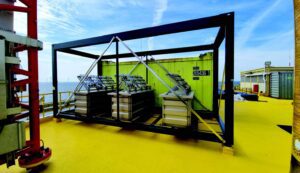With the accelerated expansion of wind energy, the offshore sector is of particular importance. On the high seas, however, corrosion in particular endangers the safety and longevity of the systems.
Text by BAM
The Federal Institute for Materials Research and Testing (BAM) has started a unique test campaign together with Energie Baden-Württemberg AG (EnBW) to advance the development of protection systems.
In order to be as economical as possible, modern offshore wind farms should remain in operation for 25 years or more. But extreme conditions prevail on the high seas: Corrosion, intensified by the maritime weather, severely affects the systems, which are up to 250 meters high. All metallic parts above the waterline are affected by the so-called ‘atmospheric’ corrosion. At the same time, the protection options are particularly limited there.
Corrosion problems
“Despite extensive research, the many factors that affect the phenomenon are still not sufficiently understood. Even with known material systems, unexpected problems with corrosion occur again and again, and they turn out to be less durable than hoped,” explains Martin Babutzka from the Wind@BAM Competence Center.
“This is also due to the fact that forecasts of the durability of materials are mostly based on short-term tests in the laboratory or simulations in climate chambers. Reliable statements on the corrosion behaviour under real conditions cannot be made on this basis. The results often even lead to incorrect assumptions, and as a result, construction elements are designed too conservatively or too risky, which in turn impairs the economic efficiency and sustainability of the systems.”
Unique weathering campaign
Martin Babutzka, together with EnBW, the third largest energy company in Germany, is now starting a test that is unique in Germany to research atmospheric corrosion in the offshore area under real conditions. Together with EnBW, the corrosion expert has designed a weathering campaign in which a total of 17 different materials and corrosion protection systems are tested for their durability directly on the high seas. The results should be made usable for industry. For the test campaign, Wilhelm Modersohn GmbH & Co. KG built an approximately six by two meter weathering box. The material samples were mounted on scaffolding in this open, container-like structure.
In the summer, a supply ship transported the structure, which weighed around three tons, to the EnBW wind farm “Hohe See”, 100 kilometers north-west of Heligoland. There it was hoisted onto a distribution station with a crane. On the central platform in the midst of 71 wind turbines, the material samples will be exposed to wind and weather for the next three years.
Various material samples

The test campaign by BAM and EnBW is the most comprehensive of its kind in Germany to date. Material samples made of steel, zinc, copper and aluminum, material variants with innovative coatings and zinc coatings as well as stainless steels in different resistance classes are tested. All samples were provided by leading companies and associations from the steel construction and galvanizing industry. At intervals of one year, samples are to be taken and examined for corrosion.
“The campaign allows us for the first time to get a comprehensive picture of the corrosion conditions on the high seas as well as really reliable data on the durability of individual materials. The results should enable companies like EnBW to optimally design corrosion protection in the future. We want to lay a scientific foundation that takes into account economic as well as ecological aspects,” says Martin Babutzka.
“From our point of view, BAM is the ideal partner for this project, because on the one hand it is involved in the approval of offshore wind turbines and conducts research in this area itself and on the other hand it has an excellent reputation and many years of experience in the field of corrosion research and materials technology,” says Sven Tannert, an expert in the area of quality assurance for steel construction and corrosion protection at EnBW.
About BAM
The Bundesanstalt für Materialforschung und -prüfung (BAM) is a senior scientific and technical Federal institute with responsibility to Germany’s Federal Ministry for Economic Affairs and Climate Action. It tests, researches and advises to protect people, the environment and material goods.
BAM sets and represents high standardsfor safety in technology and chemistry for Germany and for its global markets, to further develop the successful “Made in Germany” culture of quality. Around 1,600 people from about 50 nations work at BAM.
About this Featured Story
This Featured Story appeared in Stainless Steel World January / February 2023 magazine. To read many more articles like these on an (almost) monthly basis, subscribe to our magazine (available in print and digital format – SUBSCRIPTIONS TO OUR DIGITAL VERSION ARE NOW FREE) .
Want to contribute as author? Please contact Joanne.
Every week we share a new Featured Story with our Stainless Steel community. Join us and let’s share your Featured Story on Stainless Steel World online and in print.


